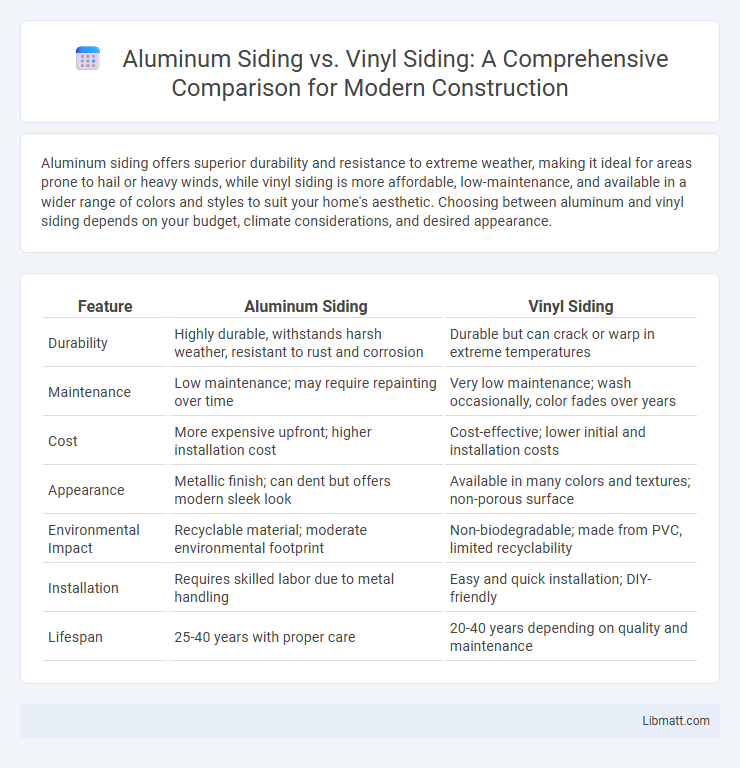Aluminum siding offers superior durability and resistance to extreme weather, making it ideal for areas prone to hail or heavy winds, while vinyl siding is more affordable, low-maintenance, and available in a wider range of colors and styles to suit your home's aesthetic. Choosing between aluminum and vinyl siding depends on your budget, climate considerations, and desired appearance.
Table of Comparison
| Feature | Aluminum Siding | Vinyl Siding |
|---|---|---|
| Durability | Highly durable, withstands harsh weather, resistant to rust and corrosion | Durable but can crack or warp in extreme temperatures |
| Maintenance | Low maintenance; may require repainting over time | Very low maintenance; wash occasionally, color fades over years |
| Cost | More expensive upfront; higher installation cost | Cost-effective; lower initial and installation costs |
| Appearance | Metallic finish; can dent but offers modern sleek look | Available in many colors and textures; non-porous surface |
| Environmental Impact | Recyclable material; moderate environmental footprint | Non-biodegradable; made from PVC, limited recyclability |
| Installation | Requires skilled labor due to metal handling | Easy and quick installation; DIY-friendly |
| Lifespan | 25-40 years with proper care | 20-40 years depending on quality and maintenance |
Introduction to Aluminum and Vinyl Siding
Aluminum siding is a durable, lightweight material known for its resistance to fire and insects, while vinyl siding offers a cost-effective, low-maintenance option with a wide range of colors and styles. Both materials provide weather-resistant protection for your home's exterior, but aluminum is more prone to denting whereas vinyl can crack in extreme temperatures. Choosing the right siding depends on your budget, desired aesthetic, and the climate in which you live.
Material Composition: Aluminum vs Vinyl
Aluminum siding consists of thin sheets of aluminum, known for its durability, resistance to rust, and lightweight properties, making it an excellent choice for withstanding harsh weather conditions. Vinyl siding is made from polyvinyl chloride (PVC), a synthetic plastic material that offers flexibility, low maintenance, and superior insulation against temperature fluctuations. Understanding the material composition helps you decide which siding best suits your home's climate resilience and maintenance preferences.
Durability and Lifespan Comparison
Aluminum siding offers superior durability compared to vinyl, resisting dents, cracking, and extreme weather conditions for up to 40 years with proper maintenance. Vinyl siding, while more affordable, typically lasts 20 to 30 years but may fade, warp, or crack under severe weather or prolonged sun exposure. Choosing aluminum siding enhances long-term investment due to its stronger resistance to environmental damage and longevity.
Maintenance Requirements
Aluminum siding requires periodic cleaning and occasional repainting to prevent oxidation and maintain its appearance, while vinyl siding is low-maintenance, needing only regular washing to remove dirt and mildew. Aluminum is more prone to dents and scratches, which may necessitate repairs or touch-ups over time, whereas vinyl is resistant to dents but can crack under extreme weather conditions. Your choice depends on how much time you're willing to invest in upkeep and the environmental factors in your area.
Aesthetic Options and Curb Appeal
Aluminum siding offers a sleek, modern aesthetic with metallic finishes and the ability to mimic wood grain, providing durable curb appeal that resists dents and fading. Vinyl siding delivers a wider range of colors, textures, and styles, including realistic woodgrain and stone looks, making it versatile for enhancing your home's exterior design. Choosing between these materials depends on your preference for maintenance, color retention, and the visual impact you want to achieve.
Cost Analysis: Aluminum vs Vinyl
Aluminum siding typically costs between $3 and $7 per square foot, making it slightly more expensive upfront than vinyl siding, which ranges from $2 to $5 per square foot. You should consider that vinyl siding offers lower installation and maintenance expenses, while aluminum siding can lead to higher costs due to potential dent repairs and repainting. Evaluating long-term durability and energy efficiency will help determine the best investment for your home.
Energy Efficiency and Insulation
Aluminum siding offers moderate energy efficiency but typically lacks built-in insulation, requiring additional foam backing to improve thermal performance. Vinyl siding often includes insulated options with foam backing, enhancing its ability to reduce heat transfer and lower energy costs. Choosing insulated vinyl siding can significantly improve home energy efficiency compared to standard aluminum siding.
Environmental Impact and Sustainability
Aluminum siding offers high recyclability, often made with a significant percentage of recycled content, reducing environmental waste compared to vinyl siding, which is derived from non-renewable petroleum-based materials and is less biodegradable. Vinyl siding production releases more toxic chemicals and poses greater environmental concerns during disposal, whereas aluminum siding can be efficiently recycled at the end of its lifespan, supporting sustainability goals. Choosing aluminum siding supports resource conservation through its renewable lifecycle benefits, while vinyl siding's environmental footprint is generally higher due to its raw material extraction, manufacturing emissions, and landfill persistence.
Installation Process and Labor Considerations
Aluminum siding requires specialized tools and skilled labor for precise cutting and fastening to prevent warping, typically extending installation time compared to vinyl siding, which offers quicker, more straightforward installation due to its lightweight panels and interlocking design. Vinyl siding installation often involves snapping panels into place over house wrap, reducing labor hours and minimizing the need for skilled carpentry. For your project, choosing vinyl siding may lower labor costs and speed up completion, while aluminum siding demands experienced installers to ensure durability and aesthetic quality.
Which Siding is Best for Your Home?
Aluminum siding offers superior durability and fire resistance, making it ideal for homes in harsh weather conditions, while vinyl siding excels in affordability and low maintenance, resisting dents and fading effectively. Your choice depends on priorities such as budget, climate, and aesthetic preferences, with vinyl providing more color options and aluminum offering a classic, sleek finish. Considering energy efficiency, vinyl siding often includes insulation options that can reduce heating costs, giving your home added value and comfort.
Aluminum siding vs Vinyl siding Infographic

 libmatt.com
libmatt.com